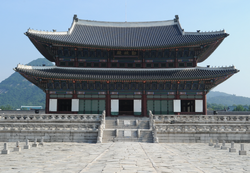| History of Korea |
|---|
 |
| Timeline |
Korea's military history spans thousands of years, beginning with the ancient nation of Gojoseon and continuing into the present day with the countries of North Korea and South Korea, and is notable for its many successful triumphs over invaders.
Contents
- Timeline
- Gojoseon
- Buyeo
- Proto–Three Kingdoms of Korea
- Three Kingdoms period
- North South States period
- Goryeo dynasty
- Joseon dynasty
- Korean Empire
- 1910–1945: Colonial period
- After 1945
- See also
- References
Throughout its history, Korea has boasted numerous exceptional leaders who gained outstanding victories against numerically superior enemies. Famed leaders credited with defending Korea against foreign invasions include: Ŭlchi Mundŏk of Goguryeo, who defeated Sui China during the Goguryeo–Sui War; [1] Yŏn Kaesomun of Goguryeo, who defeated Emperor Taizong of Tang China during the Goguryeo–Tang War; [2] [3] Kang Kam-ch'an of Goryeo, who defeated the Khitan Empire during the Goryeo-Khitan War; [4] Ch'oe Yŏng and Yi Sŏnggye of Goryeo, who defeated the Red Turbans during the Red Turban Invasions; [5] [6] and Yi Sun-shin of Joseon, who defeated the Japanese at sea during the Imjin War. [7]
Other notable leaders include: Gwanggaeto the Great of Goguryeo, who created a great empire in Northeast Asia through conquest, [8] and subjugated the other Korean kingdoms of Baekje, Silla and Gaya to bring about a brief unification of the Three Kingdoms of Korea; [9] Geunchogo of Baekje, who captured Pyongyang and established overseas territories to control much of the Korean peninsula and dominate the seas; [10] [11] Munmu and Kim Yu-sin of Silla, who united the Three Kingdoms of Korea and defeated Tang China to gain complete control of the Korean peninsula; [12] Dae Jo-yeong, who created Balhae from Goguryeo's ashes and reconquered Goguryeo lands lost during the Goguryeo-Tang War; [13] Jang Bogo of Later Silla, who created a maritime empire and commanded a powerful fleet; [14] Wang Kŏn, who united the Later Three Kingdoms of Korea and established Goryeo as the successor to Goguryeo; [15] and Yun Kwan of Goryeo, who defeated the Jurchens and constructed nine fortresses in Manchuria. [16]
During the Cold War, South Korean troops actively participated in the Vietnam War, contributing the second largest foreign military contingent after the United States. [17] North Korea also contributed soldiers, military equipment and advisors to several conflicts during the Cold War in support of the Communist bloc, including the Yom Kippur War, Ethiopian Civil War, and Ugandan Bush War. [18] [19] [20]
Today, both North Korea and South Korea field some of the largest and most lethal armies in the world. On one hand, North Korea is widely suspected of having nuclear weapons, as well as other weapons of mass destruction. South Korea, for its part, is equipped with a sophisticated conventional military with state-of-the-art weapons. South Korea currently serves in several UN peacekeeping missions around the world. The South Korean military enjoys military alliances with other countries, particularly the United States.